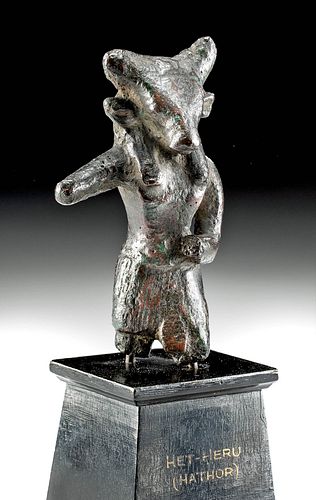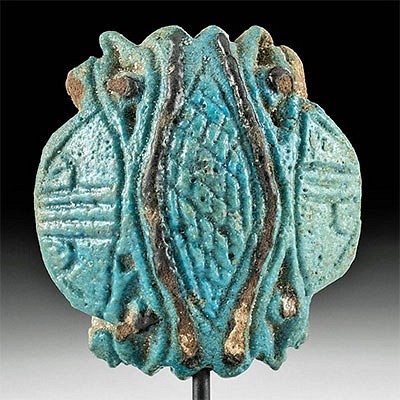Egyptian Leaded Bronze Mnevis - ex Christie's & Museum
Lot 9
About Seller
Artemis Fine Arts
686 S Taylor Ave, Ste 106
Louisville, CO 80027
United States
Selling antiquities, ancient and ethnographic art online since 1993, Artemis Gallery specializes in Classical Antiquities (Egyptian, Greek, Roman, Near Eastern), Asian, Pre-Columbian, African / Tribal / Oceanographic art. Our extensive inventory includes pottery, stone, metal, wood, glass and textil...Read more
Estimate:
$5,000 - $8,000
Absentee vs Live bid
Two ways to bid:
- Leave a max absentee bid and the platform will bid on your behalf up to your maximum bid during the live auction.
- Bid live during the auction and your bids will be submitted real-time to the auctioneer.
Bid Increments
| Price | Bid Increment |
|---|---|
| $0 | $25 |
| $300 | $50 |
| $1,000 | $100 |
| $2,000 | $250 |
| $5,000 | $500 |
| $10,000 | $1,000 |
| $20,000 | $2,500 |
| $50,000 | $5,000 |
| $100,000 | $10,000 |
| $200,000 | $20,000 |
About Auction
By Artemis Fine Arts
May 27, 2021
Set Reminder
2021-05-27 10:00:00
2021-05-27 10:00:00
America/New_York
Bidsquare
Bidsquare : CLEARANCE | Antiquities & Ethnographic Art
https://www.bidsquare.com/auctions/artemis-gallery/clearance-antiquities-ethnographic-art-7010
Featuring discounted pricing and many new items! Asian art, Classical antiquities from Egypt, Greece, Italy, and the Near East...plus Pre-Columbian, Tribal, Russian Icons & Enamelware, Spanish Colonial, Fine Art, more! Some starting prices have been reduced up to 65% from original auction prices! Artemis Fine Arts info@artemisgallery.com
Featuring discounted pricing and many new items! Asian art, Classical antiquities from Egypt, Greece, Italy, and the Near East...plus Pre-Columbian, Tribal, Russian Icons & Enamelware, Spanish Colonial, Fine Art, more! Some starting prices have been reduced up to 65% from original auction prices! Artemis Fine Arts info@artemisgallery.com
- Lot Description
**Originally Listed At $3000**
Egypt, Late Period, XXVI Dynasty, 664 to 525 BCE. Finely cast via the lost wax (cire perdue) process, a bronze statue of Mnevis, the bull-headed god worshipped in Heliopolis. The sculpture is a 3/4 figure, and while lacking the right forearm/hand and legs, presents with a nice representative form that still manages to capture the god's striding pose, with what remains of one leg advanced, the left arm bent at the elbow and crossing the body, and the upper right arm extending out. Mnevis' bold visage is comprised of curved horns, ears below, a wig/headdress gracing his shoulders, and a prominent snout. He wears a kilt-like skirt, and the surface has developed a rich, dark brown patina over the ages. Size: 1.875" W x 3.25" H (4.8 cm x 8.3 cm); 5.7" H (14.5 cm) on included custom stand.
According to Plutarch, the Mnevis bull was second only to the Apis bull of Memphis in significance. Parallel to the Apis bull, worshippers believed that the Mnevis bull's movements were determined by divine will, and were utilized as an oracle. In addition, the priesthood of Mnevis claimed that Mnevis was the father of the Apis bull.
Provenance: E.B. Collection, Orion, Michigan, USA, acquired from Royal Athena in July 1987; ex-Christie's London, April 1987. On loan to Miami University Art Museum, Oxford, Ohio, USA; Ball State University Art Gallery; George Mason University; Fitchburg Art Museum, 1988 to 2016.
All items legal to buy/sell under U.S. Statute covering cultural patrimony Code 2600, CHAPTER 14, and are guaranteed to be as described or your money back.
A Certificate of Authenticity will accompany all winning bids.
We ship worldwide and handle all shipping in-house for your convenience.
#156863Losses to both legs, left hand, right forearm and hand, and tips of both horns as shown. Minor pitting and abrasions to body, limbs, and head, with softening to some finer details. Nice earthen deposits and fantastic russet, green, and brown patina throughout. Mounted with modern brass rods through bottom of legs for display purposes.Condition
- Shipping Info
-
All shipping is handled in-house for your convenience. Your invoice from Artemis Gallery will include shipping calculation instructions. If in doubt, please inquire BEFORE bidding for estimated shipping costs for individual items.
-
- Buyer's Premium



 EUR
EUR CAD
CAD AUD
AUD GBP
GBP MXN
MXN HKD
HKD CNY
CNY MYR
MYR SEK
SEK SGD
SGD CHF
CHF THB
THB














